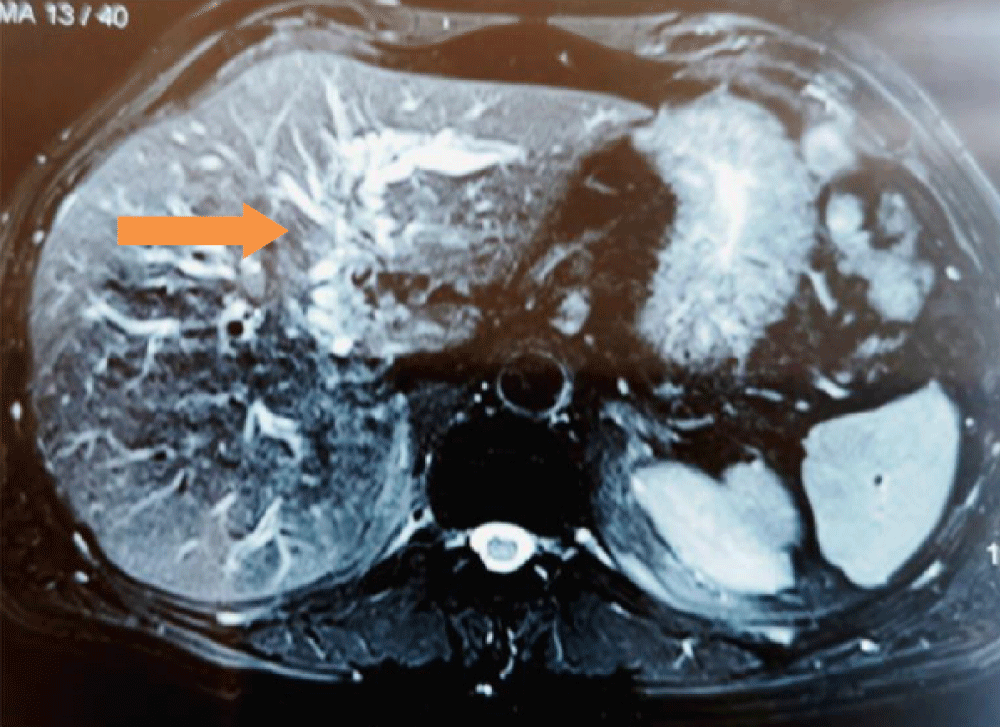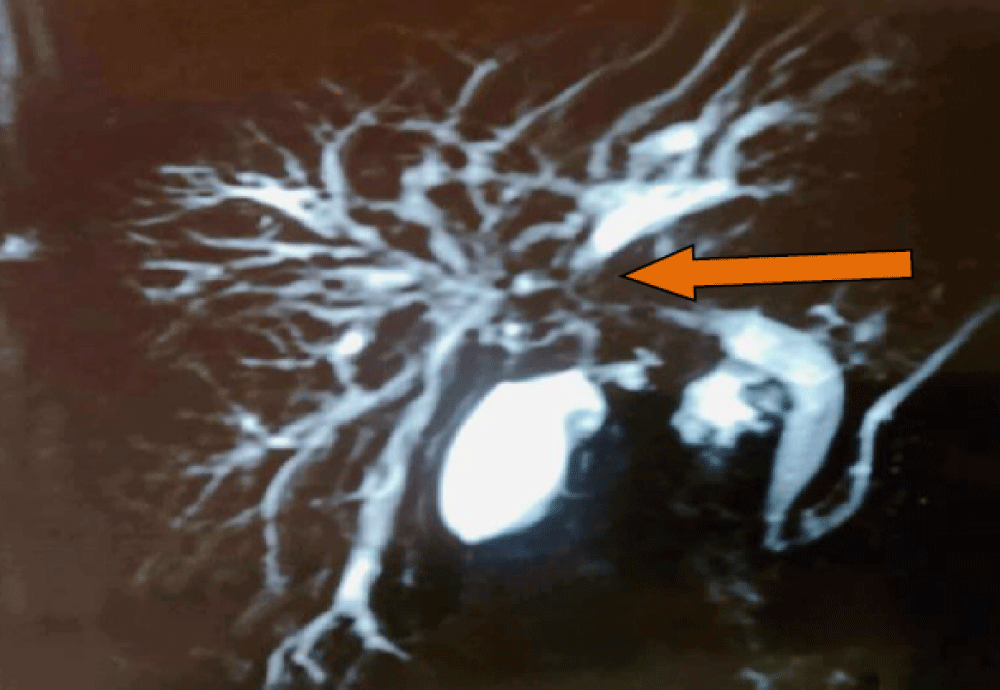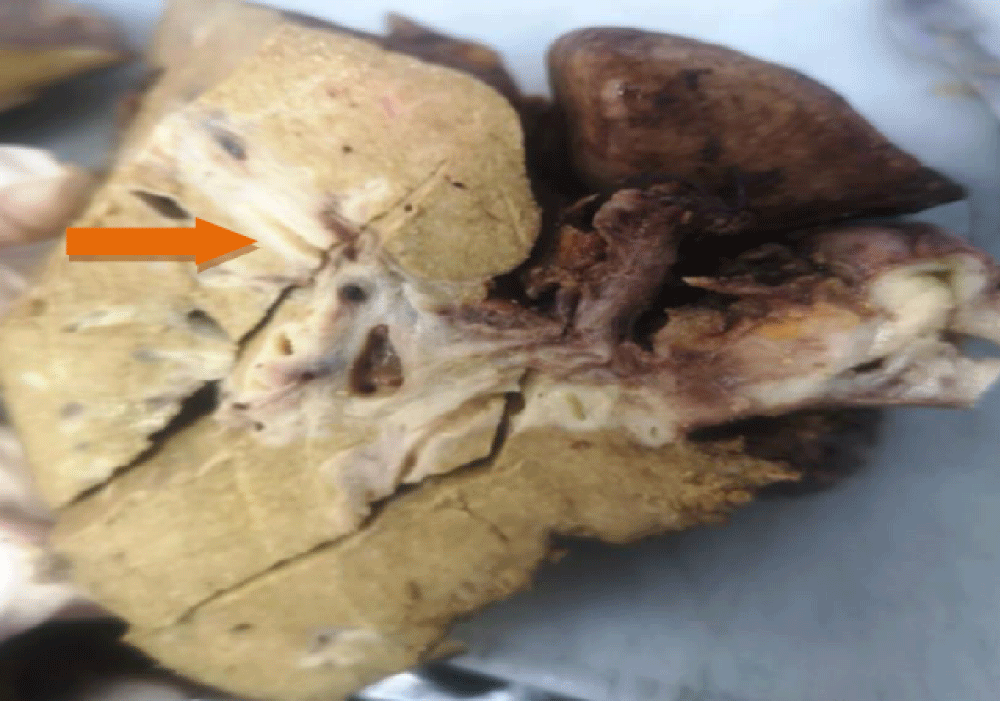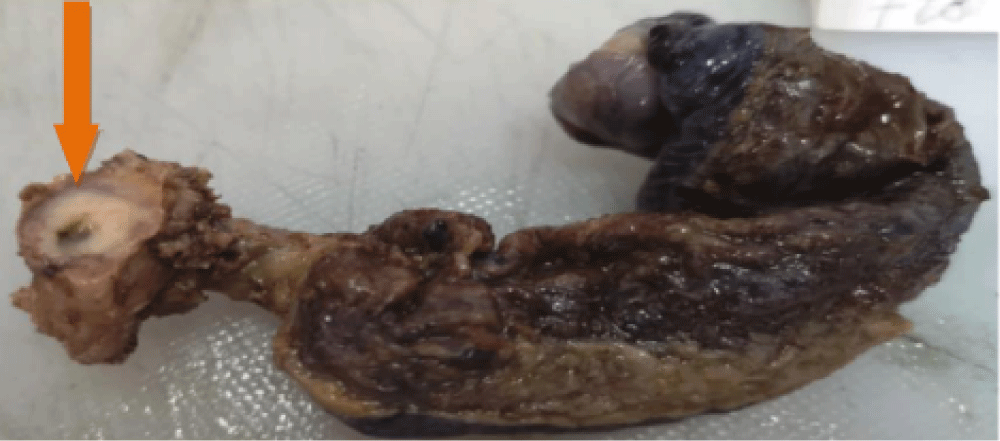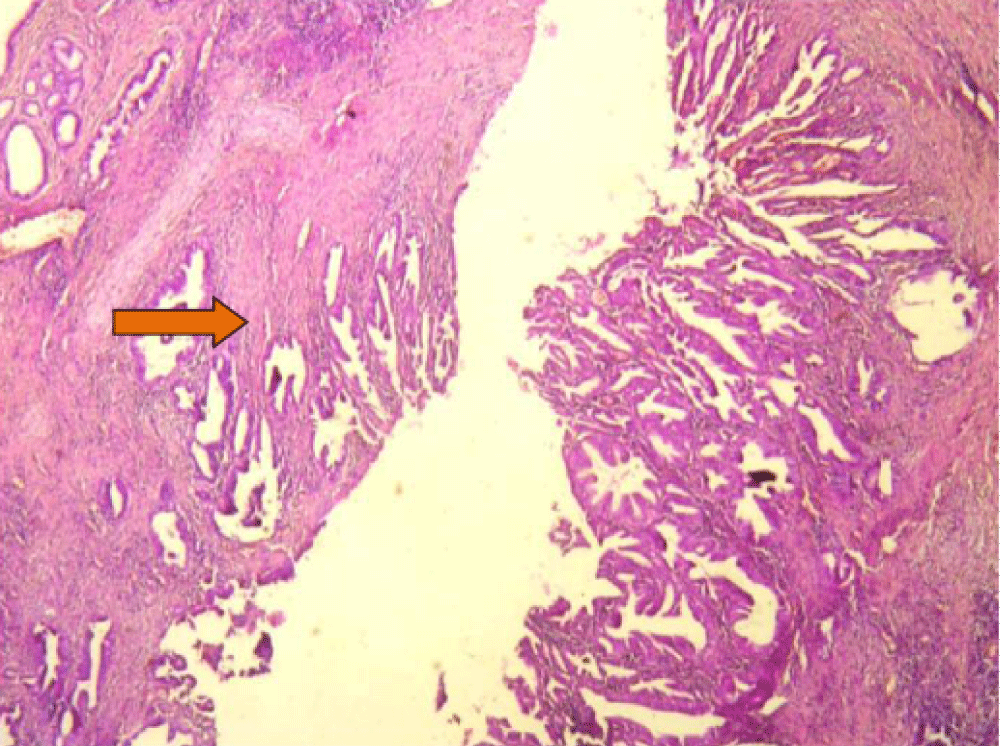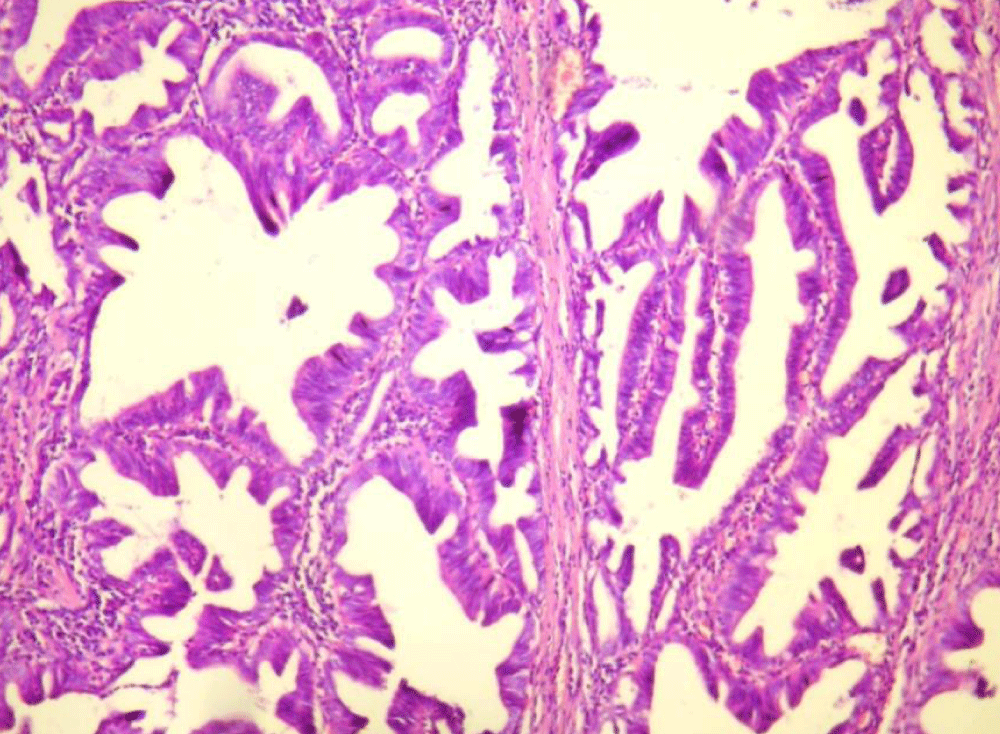More Information
Submitted: March 03, 2023 | Approved: March 20, 2023 | Published: March 21, 2023
How to cite this article: Beltaifa D, Slama SB, Guebsi S, Atallah A, Arfa N, et al. A case of hepatic intraductal papillary neoplasm of the bile duct. Arch Case Rep. 2023; 7: 007-011.
DOI: 10.29328/journal.acr.1001067
Copyright License: © 2023 Beltaifa D, et al. This is an open access article distributed under the Creative Commons Attribution License, which permits unrestricted use, distribution, and reproduction in any medium, provided the original work is properly cited.
Keywords: Bile ducts; Papillary neoplasm; Bili-MRI; Hepatectomy
A case of hepatic intraductal papillary neoplasm of the bile duct
Dorsaf Beltaifa1*, Sana Ben Slama1, Sofiene Guebsi2, Aziz Atallah2, Nafaa Arfa2, Ahlem Lahmar1 and Dhouha Bacha1
1Department of Pathology, University Hospital Mongi Slim, La Marsa, Tunisia
2Department of General Surgery, University Hospital Mongi Slim, La Marsa, Tunisia
*Address for Correspondence: Dorsaf Beltaifa, Department of Pathology, University Hospital Mongi Slim, La Marsa, Tunisia, Email: [email protected]
Introduction: Intraductal Papillary Neoplasm of the Bile ducts (IPNB) is a rare entity characterized by exophytic growth of the bile ducts.
Case presentation: In this report, we present a 57-year-old male with no prior medical history consulted for upper right abdominal pain, jaundice and pruritus. Abdominal Ultrasound (US) and magnetic resonance imaging/Bili-magnetic resonance were performed. They revealed that the circumferential parietal thickening of the common hepatic duct had extended approximately 4 cm with moderate dilatation of the left intrahepatic bile ducts. Computed tomography showed no evidence of distant metastasis.
Biopsy revealed a high-grade intraductal papillary neoplasm. After 40 days, the patient had left hepatectomy with resection of the main bile duct and the gallbladder.
Macroscopic examination of the surgical specimen showed a dilatation duct at the hilum with thickening of their walls.
The histopathology report revealed multiple intra-hepatic papillary neoplasms with high-grade dysplasia with an invasive carcinoma component in the left hepatic duct without extending to the biliary wall, classified as pT1N0.
Conclusion: This premalignant lesion has the potential to transform into invasive carcinoma if not properly diagnosed.
Our case illustrates how early identification can lead to potential surgical resection.
Bile duct neoplasms are a diverse group of benign and malignant tumors that can develop anywhere along the biliary tree [1].
Traditionally, the term biliary papillomatosis has been used to describe both imaging and pathology features. The World Health Organization adopted the term intraductal papillary neoplasm in 2010 [2].
In 2019, the World Health Organization defined intraductal papillary neoplasm of the bile ducts (IPNB) as “a grossly visible premalignant neoplasm characterized by intraductal papillary or villous growth of biliary-type epithelium” [3]. As a result, IPNB is a precancerous lesion. It is distinguished by an intraluminal papillary tumor in the dilated bile duct with a fibrovascular core [4]. However, the malignant transformation rate of IPNB has been reported to be as high as 41% - 83% [5]. Because precancerous lesions take 1 - 2 years to transform into invasive carcinoma, surgical treatment is feasible [6].
We report the case of a patient who consulted for upper right abdominal pain and was diagnosed with IPNB, with an invasive carcinoma component.
A 57-year-old male with no prior medical history was consulted for upper right abdominal pain, jaundice and pruritus. His initial laboratory values were as follows:
Total bilirubin (tbil): 139 mg/dl, direct bilirubin (dbil): 74.8 mg/dl, aspartate aminotransferase (AST): 300 IU/L and alanine aminotransferase (ALT): 135 IU/L. Abdominal ultrasound (US) and magnetic resonance imaging/Bili-magnetic resonance were performed. They revealed that the circumferential parietal thickening of the common hepatic duct had extended approximately 4cm with moderate dilatation of the left intrahepatic bile ducts (Figures 1 and 2). Computed tomography showed no evidence of distant metastasis.
Figure 1: Magnetic resonance imaging (MRI): T2 Fat Sat cross section: dilatation of the left intrahepatic bile ducts (orange arrow).
Figure 2: Biliary MRI section: circumferential, irregular and parietal thickening of the common hepatic duct extending approximately 4 cm with moderate dilatation of the left intrahepatic bile ducts.
Biopsy revealed a high-grade intraductal papillary neoplasm. After 40 days, the patient had left hepatectomy with resection of the main bile duct and the gallbladder. A manual biliary digestive anastomosis was performed. The surgical exploration showed the absence of ascites, carcinosis, and liver metastasis.
Macroscopic examination of the surgical specimen showed a dilatation duct at the hilum with thickening of their walls (Figures 3 and 4).
Figure 3: Resected specimen. Left lobectomy: dilatation of the ducts in the hilum with thickening of the wall without obvious tumour (orange arrow).
Figure 4: Resected specimen. Resection of extra hepatic bile duct and gallbladder: irregular mass in the left hepatic duct (orange arrow).
The histopathology report revealed multiple intra-hepatic papillary neoplasms with high-grade dysplasia with an invasive carcinoma component in the left hepatic duct without extending to the biliary wall, classified as pT1N0 (Figures 5 and 6).
Figure 5: Intraductal papillary neoplasm of the bile duct with an associated invasive carcinoma (orange arrow), (Hematoxylin-Eosin Stainoriginal magnification 10x).
Figure 6: High-grade biliary intraepithelial neoplasia displays severe nuclear atypia, with irregular and pleomorphic nuclei, and a complete loss of nuclear polarization, with complex stratification (hematoxylin- eosin; original magnification 20x).
The postoperative course was uneventful.
The diagnosis of hepatic cystic masses is increasing as a result of the rapid advancements in imaging. In fact, it has been estimated that 20% of the general population has cystic masses in the liver [7]. While the majority of these masses are benign cysts, 3% – 5% of them are biliary cystic malignant tumors. The most common bile duct cystic tumors are IPNB and pancreatic mucinous cystic neoplasms (MCN). IPNB was found in 10% of all resected bile duct tumors [8].
The incidence of IPNB varies geographically, accounting for 7% - 10% of all bile duct tumors in Europe and North America and 10% - 40% in Asian cohorts [9]. IPNB patients are mostly men between the ages of 50 and 70, with recurrent and intermittent pain and cholangitis. IPNB is uncommon in children, and there is no evidence of a tendency for familial aggregation of cases [10,11].
The pathogenesis of IPNB is not clear, but it may be related to repeated infection of the biliary tract and cholestasis. However, bile duct stones, Clonorchissinensis infection, primary sclerosing cholangitis and biliary malformation are considered risk factors for IPNB.
IPNB development and progression from low, high-grade dysplasia to invasive carcinoma follow a sequential acquisition of molecular alterations involving common oncogenic pathways, including KRAS, CDKN2A and TP53 genes [12].
IPNB patients frequently present with recurrent episodes of abdominal colic, intermittent obstructive jaundice and acute cholangitis.
Medical imaging doctors have an important role in the diagnosis of IPNB. They should be aware of the importance of capturing image findings of IPNB because this disease has a high potential for malignancy. IPNB may be radiologically undetectable, but in most cases, cholangiography shows filling defects in the biliary tree, caused by an intraductal mass, with dilatation of either proximal or distal bile ducts.
This diagnosis should always be considered in the presence of focal duct dilatation filled with fluid, mucin, or soft tissue, in both symptomatic and asymptomatic patients.
The prevalent location of IPNB (intrahepatic versus extrahepatic bile ducts) is highly variable among studies [10].
Surgery is considered the cornerstone of treatment, with partial hepatectomy (for localized disease) and liver transplantation along with pancreaticoduodenectomy (for extensive disease or recurrent IPBN) being the therapeutic options.
In this situation, the patient had a left hepatectomy with resection of the main bile duct and the gallbladder. A manual biliary digestive anastomosis was performed.
On macroscopic examination, IPNB appears as a papillary, villous, or polypoid, red-colored, soft mass, predominantly growing in a dilated bile duct lumen, which may be cystic or fusiform. Lesions might be single and isolated or multiple and mucus hypersecretions can be seen. An invasive component can appear as a nodular lesion [9].
On histological examination, IPNB is characterized by dilated bile ducts filled with papillary or villous structures with fine fibrovascular cores covered by biliary epithelial cells. Tubular or glandular components can be seen but not an ovarian-type mesenchymal stroma. Epithelial cells are cuboidal or columnar and may show intestinal, biliary, oncocytic and gastric-type differentiation, based on morphology and immunophenotype [10]. The biliary subtype is the most common in Western countries, while the oncocytic and gastric types are very rare. Mixtures of different subtypes are observed in about 50% of all IPNBs, so their classification is based on the most prevalent component [13].
Epithelial cells lining IPNB may show variable cytoarchitectural atypia, classified into low or high-grade dysplastic lesions. IPNBs with high-grade dysplasia are more frequent in extrahepatic bile ducts.
The extension of the neoplastic process into peribiliary glands, particularly in the hilar zone, is quite common.
Regarding our patient, he was diagnosed with IPNB with high-grade dysplasia to the left extrahepatic duct with an invasive carcinoma component.
Complete resection is a significant prognostic factor, reported in great numbers. The presence or absence of metastases to lymph nodes is a major prognostic factor along with complete resection [14].
IPNB has been known to recur in the bile duct following surgical resection. Despite that the initial Resection stump of the bile duct tested negative, intraductal papillary tumor presenting with tissue image similar to the initial resection recurred. IPNB recurs after more than 10 years in some cases, appearing as if it were new carcinoma. This suggests a multicentric growth of IPNB [15]. As a result, clinical course monitoring is required, with postoperative intraductal recurrence in mind.
IPNB is a relatively rare disease that should be considered in the differential diagnosis of hepatic cystic tumors.
IPNB can present diagnostic challenges. Each imaging modality has limitations in detecting IPNB because of its small tumor size, tumor multiplicity and tendency to spread superficially. The mainstay of treatment of IPNB is surgical resection, so an accurate preoperative evaluation of tumor extent is crucial. Thus, a multi-modality approach is needed to diagnose IPNB and establish an optimal treatment plan for these patients. This premalignant condition has the potential to transform into invasive carcinoma if not properly diagnosed.
Our case illustrates how early identification can lead to potential surgical resection.
- Guido M, Sarcognato S, Sacchi D, Ludwig K. The Anatomy and Histology of the Liver and Biliary Tract. In: D’Antiga L, editor. Pediatric Hepatology and Liver Transplantation. Cham: Springer International Publishing; 2019; 41–55. https://doi.org/10.1007/978-3-319-96400-3_3
- Ohtsuka M, Shimizu H, Kato A, Yoshitomi H, Furukawa K, Tsuyuguchi T, Sakai Y, Yokosuka O, Miyazaki M. Intraductal papillary neoplasms of the bile duct. Int J Hepatol. 2014;2014:459091. doi: 10.1155/2014/459091. Epub 2014 May 18. PMID: 24949206; PMCID: PMC4052179.
- Uemura S, Higuchi R, Yazawa T, Izumo W, Matsunaga Y, Shiihara M, Ota T, Furukawa T, Yamamoto M. Prognostic Factors for Surgically Resected Intraductal Papillary Neoplasm of the Bile Duct: A Retrospective Cohort Study. Ann Surg Oncol. 2021 Feb;28(2):826-834. doi: 10.1245/s10434-020-08835-6. Epub 2020 Jul 10. PMID: 32651697.
- Matono R, Ninomiya M, Morita K, Tomino T, Oshiro Y, Yokota T, Nishizaki T. Branch-type intraductal papillary neoplasm of the bile duct treated with laparoscopic anatomical resection: a case report. Surg Case Rep. 2020 May 15;6(1):103. doi: 10.1186/s40792-020-00864-3. PMID: 32415464; PMCID: PMC7229076.
- Pattarapuntakul T, Ovartlarnporn B, Sottisuporn J. Mucinous cystic neoplasm of the liver with extrahepatic growth presenting with ascending cholangitis diagnosed by endoscopic ultrasound features: a case report. J Med Case Rep. 2018 Feb 15;12(1):33. doi: 10.1186/s13256-017-1560-4. PMID: 29444709; PMCID: PMC5813420.
- Yi D, Zhao LJ, Ding XB, Wang TW, Liu SY. Clinical characteristics of intrahepatic biliary papilloma: A case report. World J Clin Cases. 2021 May 6;9(13):3185-3193. doi: 10.12998/wjcc.v9.i13.3185. PMID: 33969107; PMCID: PMC8080758.
- Arnaoutakis DJ, Kim Y, Pulitano C, Zaydfudim V, Squires MH, Kooby D, Groeschl R, Alexandrescu S, Bauer TW, Bloomston M, Soares K, Marques H, Gamblin TC, Popescu I, Adams R, Nagorney D, Barroso E, Maithel SK, Crawford M, Sandroussi C, Marsh W, Pawlik TM. Management of biliary cystic tumors: a multi-institutional analysis of a rare liver tumor. Ann Surg. 2015 Feb;261(2):361-7. doi: 10.1097/SLA.0000000000000543. PMID: 24509187; PMCID: PMC4655107.
- Ying S, Ying M, Liang W, Wang Z, Wang Q, Chen F, Xiao W. Morphological classification of intraductal papillary neoplasm of the bile duct. Eur Radiol. 2018 Apr;28(4):1568-1578. doi: 10.1007/s00330-017-5123-2. Epub 2017 Nov 14. PMID: 29138880.
- Nakanuma Y, Kakuda Y, Uesaka K. Characterization of Intraductal Papillary Neoplasm of the Bile Duct with Respect to the Histopathologic Similarities to Pancreatic Intraductal Papillary Mucinous Neoplasm. Gut Liver. 2019 Nov; 13(6):617–27. https://www.ncbi.nlm.nih.gov/pmc/articles/PMC6860037/
- Park HJ, Kim SY, Kim HJ, Lee SS, Hong GS, Byun JH, Hong SM, Lee MG. Intraductal Papillary Neoplasm of the Bile Duct: Clinical, Imaging, and Pathologic Features. AJR Am J Roentgenol. 2018 Jul;211(1):67-75. doi: 10.2214/AJR.17.19261. Epub 2018 Apr 9. PMID: 29629808.
- Luvira V, Somsap K, Pugkhem A, Eurboonyanun C, Luvira V, Bhudhisawasdi V. Morphological Classification of Intraductal Papillary Neoplasm of the Bile Duct with Survival Correlation. Asian Pac J Cancer Prev APJCP. 2017; 18(1):207–13. https://www.ncbi.nlm.nih.gov/pmc/articles/PMC5563102/
- Schlitter AM, Born D, Bettstetter M, Specht K, Kim-Fuchs C, Riener MO, Jeliazkova P, Sipos B, Siveke JT, Terris B, Zen Y, Schuster T, Höfler H, Perren A, Klöppel G, Esposito I. Intraductal papillary neoplasms of the bile duct: stepwise progression to carcinoma involves common molecular pathways. Mod Pathol. 2014 Jan;27(1):73-86. doi: 10.1038/modpathol.2013.112. Epub 2013 Jul 5. PMID: 23828315.
- Kim KM, Lee JK, Shin JU, Lee KH, Lee KT, Sung JY, Jang KT, Heo JS, Choi SH, Choi DW, Lim JH. Clinicopathologic features of intraductal papillary neoplasm of the bile duct according to histologic subtype. Am J Gastroenterol. 2012 Jan;107(1):118-25. doi: 10.1038/ajg.2011.316. Epub 2011 Sep 27. PMID: 21946282.
- Onoe S, Shimoyama Y, Ebata T, Yokoyama Y, Igami T, Sugawara G. Prognostic delineation of papillary cholangiocarcinoma based on the invasive proportion: a single-institution study with 184 patients. Surgery. 2014 Feb; 155(2):280–91.
- Nakanishi Y, Kondo S, Hirano S, Ambo Y, Tanaka E, Morikawa T. Recurrence of mucosal carcinoma of the bile duct, with superficial flat spread, 12 years after operation. J Hepatobiliary Pancreat Surg. 2006; 13(4):355–8. https://onlinelibrary.wiley.com/doi/abs/10.1007/s00534-006-1092-6
